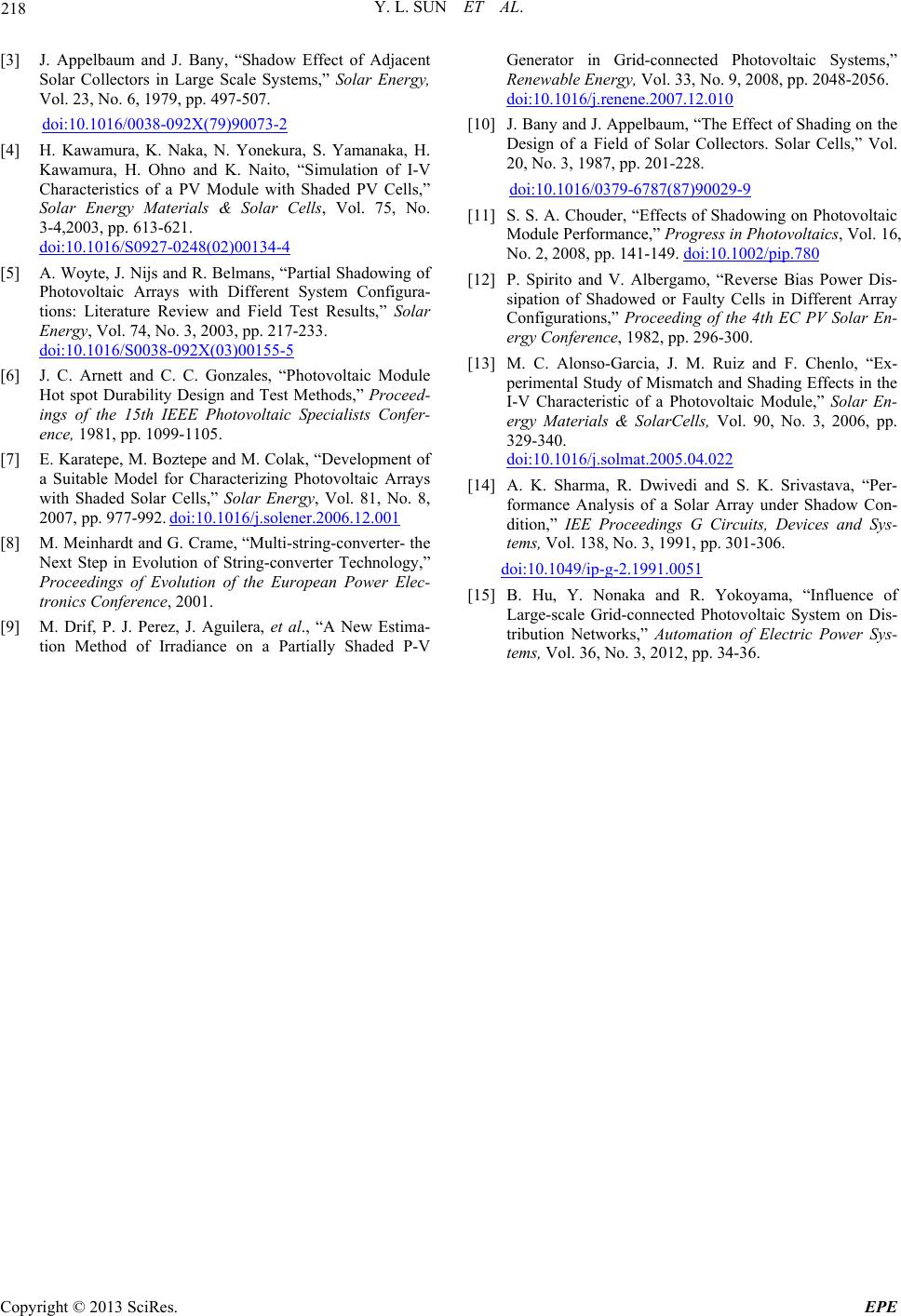
Y. L. SUN ET AL.
Copyright © 2013 SciRes. EPE
218
[3] J. Appelbaum and J. Bany, “Shadow Effect of Adjacent
Solar Collectors in Large Scale Systems,” Solar Energy,
Vol. 23, No. 6, 1979, pp. 497-507.
doi:10.1016/0038-092X(79)90073-2
[4] H. Kawamura, K. Naka, N. Yonekura, S. Yamanaka, H.
Kawamura, H. Ohno and K. Naito, “Simulation of I-V
Characteristics of a PV Module with Shaded PV Cells,”
Solar Energy Materials & Solar Cells, Vol. 75, No.
3-4,2003, pp. 613-621.
doi:10.1016/S0927-0248(02)00134-4
[5] A. Woyte, J. Nijs and R. Belmans, “Partial Shadowing of
Photovoltaic Arrays with Different System Configura-
tions: Literature Review and Field Test Results,” Solar
Energy, Vol. 74, No. 3, 2003, pp. 217-233.
doi:10.1016/S0038-092X(03)00155-5
[6] J. C. Arnett and C. C. Gonzales, “Photovoltaic Module
Hot spot Durability Design and Test Methods,” Proceed-
ings of the 15th IEEE Photovoltaic Specialists Confer-
ence, 1981, pp. 1099-1105.
[7] E. Karatepe, M. Boztepe and M. Colak, “Development of
a Suitable Model for Characterizing Photovoltaic Arrays
with Shaded Solar Cells,” Solar Energy, Vol. 81, No. 8,
2007, pp. 977-992. doi:10.1016/j.solener.2006.12.001
[8] M. Meinhardt and G. Crame, “Multi-string-converter- the
Next Step in Evolution of String-converter Technology,”
Proceedings of Evolution of the European Power Elec-
tronics Conference, 2001.
[9] M. Drif, P. J. Perez, J. Aguilera, et al., “A New Estima-
tion Method of Irradiance on a Partially Shaded P-V
Generator in Grid-connected Photovoltaic Systems,”
Renewable Energy, Vol. 33, No. 9, 2008, pp. 2048-2056.
doi:10.1016/j.renene.2007.12.010
[10] J. Bany and J. Appelbaum, “The Effect of Shading on the
Design of a Field of Solar Collectors. Solar Cells,” Vol.
20, No. 3, 1987, pp. 201-228.
doi:10.1016/0379-6787(87)90029-9
[11] S. S. A. Chouder, “Effects of Shadowing on Photovoltaic
Module Performance,” Progress in Photovoltaics, Vol. 16,
No. 2, 2008, pp. 141-149. doi:10.1002/pip.780
[12] P. Spirito and V. Albergamo, “Reverse Bias Power Dis-
sipation of Shadowed or Faulty Cells in Different Array
Configurations,” Proceeding of the 4th EC PV Solar En-
ergy Conference, 1982, pp. 296-300.
[13] M. C. Alonso-Garcia, J. M. Ruiz and F. Chenlo, “Ex-
perimental Study of Mismatch and Shading Effects in the
I-V Characteristic of a Photovoltaic Module,” Solar En-
ergy Materials & SolarCells, Vol. 90, No. 3, 2006, pp.
329-340.
doi:10.1016/j.solmat.2005.04.022
[14] A. K. Sharma, R. Dwivedi and S. K. Srivastava, “Per-
formance Analysis of a Solar Array under Shadow Con-
dition,” IEE Proceedings G Circuits, Devices and Sys-
tems, Vol. 138, No. 3, 1991, pp. 301-306.
doi:10.1049/ip-g-2.1991.0051
[15] B. Hu, Y. Nonaka and R. Yokoyama, “Influence of
Large-scale Grid-connected Photovoltaic System on Dis-
tribution Networks,” Automation of Electric Power Sys-
tems, Vol. 36, No. 3, 2012, pp. 34-36.